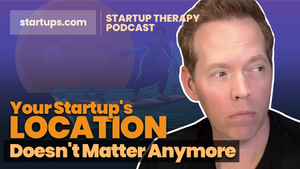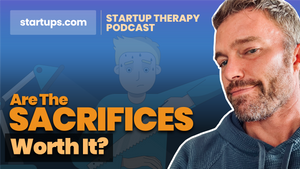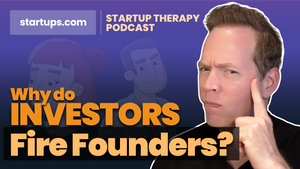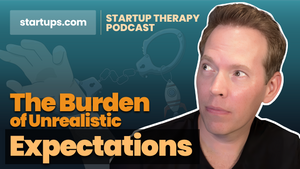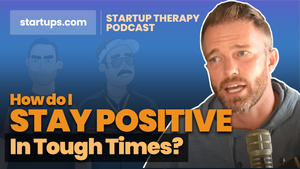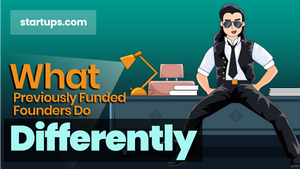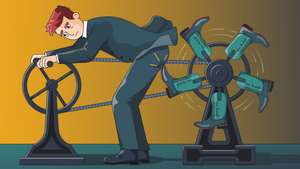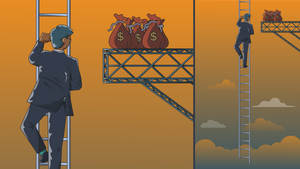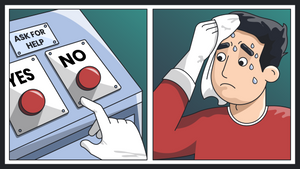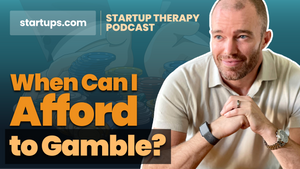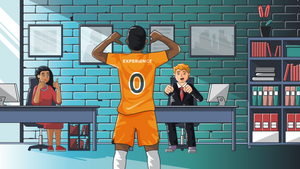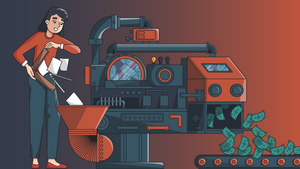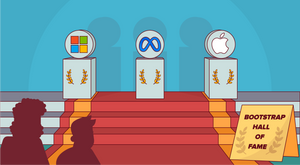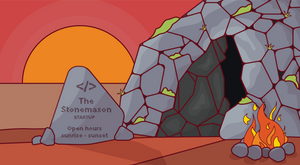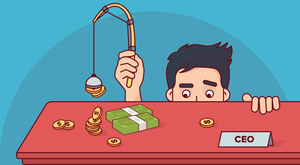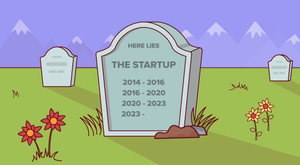Find this helpful?
This is just a small sample! Register to unlock our in-depth courses, hundreds of video courses, and a library of playbooks and articles to grow your startup fast. Let us Let us show you!
Submission confirms agreement to our Terms of Service and Privacy Policy.
Already a member? Login
AI Generated Transcript
Ryan Rutan: Welcome back to another episode of the start up therapy podcast. This is Ryan Rotan joined as always by my friend, the founder and CEO of start ups dot com. Will Schroeder will. Today, we would like to dig into something big for founders, right? This idea that we have to aim for these massive massive outcomes. But we wanna question that and say that maybe the success should be defined not really by how much we've raised, but by how much we retain. And, you know, we've talked about this in the past around optimizing for the probability of an outcome, not just the size, but I think today we can break down a little bit more of the math around that and, and dig into some of the gotchas involved with taking on funding to create a quote unquote bigger outcome.
Wil Schroter: Yeah, I think a lot of people have this, this concept and I've heard this trope endlessly and, and throughout my fundraising throughout building start ups, I'm OK, having a smaller piece of a bigger pie in, in the assumption there is that that smaller piece is a smaller piece of billions of dollars, you know, bill gates, single percentages of, of Microsoft and yet he's, you know, gazillionaire. Yes, that's true. No, it probably won't apply to you, right?
Ryan Rutan: Because sometimes that smaller piece is actually smaller. When people say that what they mean is I would rather have a smaller piece of a bigger pie implying that relative to that first pie, my piece will be bigger. But then they get the piece and they're like, wait a minute, this is smaller. And like, remember when you said you'd be happy to take a smaller piece of a bigger pie. Voila. Here you are, we have delivered smaller pieces. A
Wil Schroter: given the bigger pie. Not so much. So I think today and this is gonna be helpful for people every stage, whether you've raised or not. You know, when you're thinking like I own 100% of this thing I want to go raise and I'm gonna own less. How much less exactly am I going to own? And I wanna, we're gonna talk very specific numbers today. You're gonna know exactly what is on the other side of that door and exactly how much harder it is to get out of this thing, the more money you raise and the less probability there is. Yeah. Yeah, because
Ryan Rutan: I think that the idea is that by raising more capital that we're, we're opening doors to success, right? We're also closing doors on potential exit outcomes, right? And this is the quiet part that we want to be to bring out a little more loudly today to make sure people are paying attention to because it's often hard to see at that early stage.
Wil Schroter: And by the way, the data we're going to draw from today, we're not making this up. This was data that was drawn from capture capt management company that had access to over 5000 in funded cap tables. So they can see exactly how delusion works, et cetera. So unlike most of the things we're doing, we're not making it up because we're actually pulling real stats data. But let me paint a picture. We're gonna talk, do a tale of of two start ups. We're gonna do the tale of one start up that raise, let's say a seed round, right? And for those of you that aren't super familiar, the rounds go pre seed, which is usually it varies but less than 500,000 a seed round to say 500,000 to a few million. And then series ABC and D from traditional venture capitalists that are gonna range from 5 to 10 million up to 100 to 500 million plus. So we're gonna do a Tale of Two start ups, right? I think this will help us kind of look at both teams start up. A is a seed funded company they've raised doesn't really matter that number, let's say a million five just for Yeah. And the founding team now has 60% left in their company among them, right? Spread
Ryan Rutan: across whatever number of founders there were, by the way, this is the number. So if you're thinking, wow, why did they give up so much equity? Great question. But that is the likelihood, right? This is again, this is based on that data that says after seed round 60% is what the the the founding team will have left.
Wil Schroter: Correct, correct, which is gonna really terrify you when we get into the other team. So seed round team 60% leftover spread across three founders. OK. Cool. That's team A team B is the team that we read about in blogs and on Twitter and everything else like that, they're all over the press team B has raised through their series D round. It doesn't matter how much they raise that's actually not material. But my guess is that they've probably raised between 2 to $300 million at this point. Probably probably more. By the time you get to a series D round, are there E and F rounds? Yes. Usually by the time you get to E and F something's going wrong because you're delaying an IP O or a major sale. Sometimes there's good reasons. Usually there's not, especially now. And by the time you get to series D, the average company that can even make it that far, right. That's, that's hard to do, right. It's not easy to get to ad route by the time of the average company gets to ad route per cap share, brace yourselves. The entire founding team will have between 11 to 17% of the whole company before you split it three ways. Ouch. I don't know that many founders that have made it to D rounds that are in single digits. Yeah. So everything we're about to talk about is gonna compare these two teams and these two hypothetical paths, someone who never made it past C and someone who made it all the way to D and now we're gonna talk about how big of an exit each of these companies need to make in order to make the same amount of money. Yeah. Exactly. Terrifying.
Ryan Rutan: Yeah. You know, it's, it's amazing too because as you're watching these companies raise funds and you're talking to companies that are raising funds and they're celebrating round after round after round, right? You're celebrating growth. But I'm also just, I'm, what I'm hearing is that shrinking tat cap table that reduced odds of ever getting to that exit the entire time, that celebration is going on. Like, what are we actually celebrating here? Right. It's an amazing tool, right? It can be an amazing tool, but it's a two edged sword at the same time, we're like chopping that path away towards growth. We are also shaving off percentage point after percentage point from our final exit, right? And it's just so scary to watch that happen.
Wil Schroter: It is, and it's the cost of doing business, right? There are very few founders who escaped this. Now that said, let's talk about the optionality. OK. Of team a team A s uh you know, raised a smaller amount of money. They haven't grown the company a ton, right? I mean, in most cases for that, that amount of money, but each of the founders still has 20% right? Which is a, which is a fair bit of equity. Sometimes folks, when they're thinking about like, you know, hey, how much do I have of a company? Whatever they're thinking like, oh, I have to have like 50% or 70% dude, the moment you're going to raise money that, that, that is out the door, there's no way you're gonna sit around that much. Now, can I think of a few examples of off the top of my head, Ryan of friends of mine that have exited lately? Not lately.
Ryan Rutan: I just gonna say, mm let's, let's wind that back a bit.
Wil Schroter: Yeah. Yeah. Yeah. The calendar is getting thrown but that have had like 70 80%. Yeah, I actually can't. But same thing, those weren't big funding rounds. So one guy I'm thinking of sold his company for 70 million, had 80% of it and he raised $800,000 right? Three seed round at this point, pretty much seed round, right? Another guy grew, his company sold it for just under 20 million. And boy, I think only raised like $500,000. So had like 80% of the company still, right. Still a great exit. I'm using those as two examples off top of my head, actually, companies you've heard of, I won't mention them because, because I won't say who they are to connect the cap tables. But both had life changing exits. Neither had massive amounts of revenue. Right. In both cases, I think they were around 10 to $20 million in revenue. One had 10, the small exit, the other had 20 the larger exit. But what was interesting is they had a lot of options. Hey, these weren't big companies by venture standards, but at $10 million there's a lot of places you can take that, a lot of places you can take it. That's where our story begins. Yeah, I mean,
Ryan Rutan: look no further than something like Zillow for a proxy on this. Right. Take a look at the number of houses that are for sale. Well, I probably have to update my numbers now, but for between 500,000 and a million dollars. Right. And then a million to 2 million, 2 million to 4 million, 10 to 20 million, 25 to 30 million, the inventory gets a lot smaller and that's not because $20 million houses are that much harder to build. They're just a lot harder to sell. You just don't have as many buyers as the, as the price continues to go up, the, the buying pool becomes way way smaller
Wil Schroter: and the types of deals you can do become a lot smaller. I I'll give you an example. If you wanna sell something for, let's say $20 million there's like a dozen different structures you can put in place, right? Somebody could buy you for $5 million and you could earn out like the next $15 million over a series of years with milestones. The number of people who could put together a $5 million you know, starting price is extraordinary. There's a ton of people that could do that deal. You know who some of those people are that you wouldn't think about are private equity companies. And they specifically do deals like this, right? Small market, small cap, private equity companies that are looking at at companies doing minimum of 5 million in revenue, usually a lot more like 10 million, 20 million, et cetera. But man, you got a 10 or $20 million company that's throwing off some decent profit. There's like literally 1000 ps that you can talk to to work out a deal. You'll get more or less the same out answers from all of them, but buyers owe plenty. You now have something that's raised 304 105 $100 million. They're like not calls, you can make your statement and people who can write that deal dramatically
Ryan Rutan: different and at that point, if you're making calls, there's almost no chance it's gonna happen. Because if you're to the point where your deal is big enough that it requires one of those nine, they've heard of you and they're either going to call you or they're not right. You picking up the phone isn't going to change that outcome.
Wil Schroter: You bet. And so let's talk about, we'll use this as the benchmark. Let's talk about the outcome of company a company a let's say I'm just making this number up to see as the reference is maybe doing $8 million ok? In total total top line revenue, nothing crazy. Respectable but nothing crazy. They put a deal together to sell for $40 million ok? So five X top line, it depends on the type of company, et cetera, type of revenues, whatever, maybe their growth rate, but that's not unreasonable, right? And that's not an insane milestone to get to. It's actually, you know, it's a, it's a very respectable exit for that amount. 100%. Now, how much does each founder make on that deal? $40 million exit. Each founder has still 20%. So actually a pretty healthy chunk, decent
Ryan Rutan: life changing amount of
Wil Schroter: money. About 8 million bucks. Yep. Right. I mean, dude, that's a lot of money. And I always make this joke pe when people don't say that's a lot of money, it's probably because they don't have it. Right. Somebody gives you $8 million. I can guarantee it's a lot of money. Your tune changes. Right. Right. Right. And so you look at that, I wanna pause there. I wanna sit on this one for a second and I wanna say the three of us, we built a company, we got to say 8 million an A RR 10 million an A RR a pretty achievable milestone. Right. Not, not easy. Right. Nothing is easy but a pretty achievable milestone. And we sold for 40 million. Did the investors get rich? They did not, right. Um They also didn't get rich in all the things that failed but but they did get a return and we made a life changing amount of money on a deal. We could have probably done 100 different ways, meaning lots and lots of buyers so that we had both optionality and enough incentive uh cash coming back to us to make it worth our while to
Ryan Rutan: make it worth doing the deal. Exactly that
Wil Schroter: this story isn't about them. The story is about is about Team B, right? Who up until now and I have massive respect for Team B. I just wanna be clear, right? But the story we're about to tell you is basically me repeating the stories of these founders from Team B, right? So this isn't like me being critical of their path. I'm saying I've had countless hours with these folks, this story and it's always the same. Here's what it looks like. Team B, let's put a number in place, right. Uh, how much they raised? Let's say it's not a lot, not a lot by series D standards. It's 100
Ryan Rutan: billion, 100 million. Yep. Deal.
Wil Schroter: And it would look something like this. I'm doing really rough cuts a few million dollars in their pre seed seed. Let's say it almost doesn't matter. It's a rounding error, right? 10 million in their A round. Ok. Let's say they did 30 million in their B round and they did 60 in their D route. Ok. So total about 100 million bucks. Now, in order to be able to get the same $8 million outcome as a founder, we have to sell for $240 million for our 4% to become worth $8 million. Did I get that right? Oh, no. 200 million $200 million. 200 million.
Ryan Rutan: Yep. It's ok. I liked the extra 40 on there was, is that the part we keep for telling this story?
Wil Schroter: It's right. Exactly. Little commission. So $200 million in theory, 4%. And again, we're, we're on the kind of lower end of the cat table dilution for our 4% to generate $8 million for us. And now we might look at that and go well, dude, if you put $100 million into a company, then a $200 million exit doesn't seem that unreasonable and that would be absolute bullshit reasoning. It doesn't work. That's
Ryan Rutan: not how it works. Now, the number of zeros in the fundraise does not necessarily actually doesn't correlate at all to the number of zeros that end up in your bank account as the founder
Wil Schroter: at the end, it does not. There's a prevailing theory in the investment community in, in the bank funded start up community that start ups who have raised a lot of money, command a special premium on exit because all that money kind of proves the company a bit. And then there's a little bit of truth to that. There's a little bit of truth that like, well, we wouldn't lowball them because we know the investors have, you know, x amount of money into this thing. There's a
Ryan Rutan: major factor in there that's skewing that for me. And that's that they have to demand a premium on that because if they don't demand a premium on that, why the hell are we selling? Because if we don't demand premium, we're not really that liquid. At that point, we've raised so much money that we have to demand that much more. So I would say that that stat or that prevailing thought is probably more driven by the fact that yeah, you have to go out and ask for the big exits. Otherwise they're just not worth doing. Everybody's gonna say no to it,
Wil Schroter: right? And this is, you know, you touched on this at the top of the episode. This is where things start to get real gnarly because this is the part that not a lot of people hear about the rest of this story they hear, oh, company raise $100 million 100 million dollars. Sounds fantastic. It is. Right. That's a lot of money. You do a lot of great things with what you don't often hear because they're not really talking about. This is how the founders feel at that point. Here's where I see a typical series C series D founder here are like the most common traits. Number one that they, they've been at this a while just takes time to get there. Right. So, minimum 6 to 7 years, minimum, more likely 9 to 10 years. Right. By the time they're at this point and people forget about that. They're like, oh, yeah. Well, that company just got started like, dude, no, they didn't. That guy's been around way longer than
Ryan Rutan: you just heard about them, but they've been around a long time. They've been grinding this out for a decade.
Wil Schroter: Yeah. You know, something that's really funny about everything we talk about here is that none of it is new. Everything you're dealing with right now has been done 1000 times before you, which means the answer already exists. You may just not know it, but that's ok. That's kind of what we're here to do. We talk about this stuff on the show, but we actually solve these problems all day long at groups dot start ups dot com. So, if any of this sounds familiar, stop guessing about what to do. Let us just give you the answers to the test and be done with it. And so the founder that's sitting in that chair at that very moment is tired. Right. You know how hard it was to get there right now that it was easy for anyone else, but that is a brutal, brutal run. Ok. Now, so that's the first part. The second part is so they're tired. The second part is, hey, how many places could I possibly sell this thing in order to get at least $200 million? Not that many places? Ok. So here's where things start to get real gnarly. And I think your house analogy was perfect at $200 million. Again, if you're doing a one for one exit to get the same outcome as that, that seed series, the company did at $40 million at $200 million you have only big players that can do those deals. You have very few private equity companies that are specifically in your space that are specifically willing to write checks of that size, et cetera. And they're not writing premiums for those of you that aren't familiar with private equity, private equity are the pawn shop of start ups. They're where you go where you can actually get money. But by definition, it's the lowest amount of money that you'll ever get because their job is to buy very low under market and try to sell it up
Ryan Rutan: higher. They get cash flow. It's not a strategic investment. They're
Wil Schroter: the opposite of your best possible outcome, but like cash advance or a pawnshop, they're consistent. They always have the money ready in hand. Great. So with that said, there are very few private equity shops that I can take this to because it's a huge check, right? That, that's, that's a very hard thing to digest. Ok. Second part strategics like, oh well, you know, Google buys companies all the time. Not really, no, no at the size of Google compared to the number of net transactions that they report and put out there, it ain't that high and when you start going net transactions, 200 million or higher, what are they like? 45 on a good year? Six, right? Not that many. And that's Google like one of the most acquisitive companies out
Ryan Rutan: there. You also have to remember that like not only does the, not only does the population of people who can write those checks become that much smaller, the scrutiny with which they run you through to write those checks and the number of options that they have, they get to pick from the best. But it doesn't mean that they also only do $200 million deals. I think this is the, the, the fallacy. This is where my, my analogy around the houses breaks down. If you've got six million dollars to buy a house. Well, no, if you're a real estate investor, you might. Right. So instead of buying 1 $16 million house, you might buy $16 million homes so they can write smaller checks to more companies. So it isn't a foregone conclusion that it is because you've reached the $200 million funding round that there's somehow just magic investors out there who just, oh, we are the $200 million funding people. No, they're, they're up to 200 million or around 200 million. They can do any smaller number as well and they get the looks at all the deals, right? They get preference on whatever they want.
Wil Schroter: Now, a whole bunch of things happen from here and I think this is where things start to get really funky. And this again, this is the part of the founder story that we tend to not hear. And I really wanna share the founders looking at this again. Let's be generous and say they're only seven years into it. And then that would be wow, pretty young series Day. I'm only seven years into it. Here's what I'm looking at. I'm glad I raised the money. Boy, that was hard to do and it was. But now what, now I've got 4% of the company now, the probability that we're gonna find a sweetheart deal are among ones of people. And you said this at the top of the episode and we've kind of been talking to them. It's not like they don't know who we are. Right. We're a big enough player in the space. People know who we are. The probability that we're gonna jump to the next, next level where we go public. If we were about to file our s ones, we'd have done it by now, right? Like we be on that path. We're sort of not and maybe we get there someday. Probably not statistically. So how do I get out of this thing? And by the way, I've got to sell for at least $200 million. And again, we haven't gotten the big rub, which is preferences and things like that. We'll get into that in a second. Folks that we were listening, you were like, wait, you forgot about the preference stack. We, we're about, we're gonna talk all about that. And so I've got to sell for $200 million. I've got a very limited number of people that would give me the opportunity, the ability to have that exit. That kind of exit comes under a massive amount of scrutiny. Nobody's taking a flyer. It's probably not a good situation, et cetera. And the investors have so much money into this thing. They kind of can't mess around with a half assed exit, right? Like get a substantial amount of money back. Whereas in the first company we had maybe a million five raise. Those are all individuals at that point for the most part, right? All individuals,
Ryan Rutan: small amount of money and a short amount of time, right? In, in terms of so like the the return may be commensurate with their expectation at that point. But, you know, certainly they're not going to be pushing back as hard as somebody who's at that $200 million level where now we really have to show them something for
Wil Schroter: them said differently. At a million five seed round. You're the person. Everybody's forgotten about at 100 million dollar D round. Nobody's forgotten about you. Everybody is definitely remembering you and they expect to get their money back and they need to. Now let's play this out further. We just ran the math that set at $40 million of an exit for company. A each founder would get $8 million right at $200 million of an exit in company b at 4% each of the founders would get $8 million. So technically, it's the same except it's not
Ryan Rutan: holding aside all of the additional work time, stress strain, forget about all that for a minute. Hit him with it will.
Wil Schroter: Now we're going to talk about something called a preference. And for those that are unfamiliar, trust me. If you ever raise money, you're or try to sell a company be well familiar with what a preference
Ryan Rutan: is. Hold on exactly that point for a second because how many founders do you know who found out what preferences were at the time of sale? Not at the time of closing the funding round.
Wil Schroter: It's one of those things. It's in your term sheet. It's very, you know, prevalent in the term sheet, but you just don't give it much thought because everyone is concerned about the preference. Everyone's concerned about how much dilution they give up and what the valuation is. What's
Ryan Rutan: the percentage, right? It doesn't matter that
Wil Schroter: day for those that don't know. And we always like to explain things for the first time because I always say there's no reason you should know this a preference is an investment term where the investor has the opportunity to get their investment amount out first, the liquidation of a company and then you split the rest of the proceeds pro rata, which means based on your percentage that you own. Quick example, if a company sells for $10 million and I'm the investor and I have a $2 million preference means which means in this case, I invested $2 million and I have what's called A one X liquidation preference when the company sells, I get my 2 million back first and then everyone else gets their percentage of the remaining $8 million. Now, in that case, you might look at it and go, well, you know, it's not too bad. I mean, like, you know, $2 million off 10, it sucks. It's a haircut. But, you know, there's still some, some meat on the bone after. Now. Imagine your preference is $100 million or $300 million or a billion dollars. Right
Ryan Rutan: back to that discussion around demanding a higher, a higher value for the deal. This is where this comes from, right. You know, well, we literally can't sell for less than $300 million now because we have preferences that up to that. So if we sell, I pocket exactly zero
Wil Schroter: dollars. Ok. So let's play that out. So, same deal. Team B they've sold for $200 million they've raised $100 million most likely all that $100 million sits on a preference. What does that mean? That means basically, instead of for selling for $200 million I sold it for the equivalent of $100 million and I get my percentage thereof, which would be $4 million.04 percent of $100 million. That's a hell of a lot different. Oh, by the way, if, if I wanna be able to get to my 8 million again, I've got to sell for $300 million. Let me tell you something, the Delta in selling something for any amount of money. But for our 200 million versus 300 million is massive, is massive.
Ryan Rutan: When you look at exits, when you look at exits by size, they taper off very quickly. Right. It comes down and down and then it just goes off an exponential cliff to much lower numbers.
Wil Schroter: Yeah. Now for those of you that have been watching all these companies get funded throughout the years and this isn't something new. I just, it's kind of, you know, fresh in everybody's minds said, hey man, we had an amazing funding run. These companies are getting huge valuations, huge funding rounds, et cetera. Yeah. But if you talk to those founders and you know, I know a lot of these founders, these are really good people, you know, way more humble than people think they are behind closed doors. They're all saying the same thing, what the fuck? It's like I was supposed to raise all this money. I was getting high five from everyone, but now I've got a 204 106 $100 million preference, which by the way you get for folks at home means if I've got a $200 million preference and I sell for $200 million I get $0. Now I get a little bit ce I get $0. So I've worked 7 to 10 years for something. I busted my ass. I did everything right. I, I raised the money like I was supposed to, I told the story, I was supposed to, I for $200 million which is an incredible exit by the way and I got nothing for it. Now, imagine you're that founder and you're gonna wake up tomorrow morning, go, like I need to go kill myself at work for a high statistical probability that I will get nothing from this effort. Sounds cool. Sounds cool right now. Just keep saying this because it's important because it's also my friends that is a tough barrel to be sta you know, staring down the barrel of now for sure you could run. You could make the counter argument, you could say yes. So is having 20 grand in the bank, right? And be on the verge of bankruptcy. Like it's, you know, it's, it's not like only they have problems and you could say they have higher class problems, but this shit is real. It is.
Ryan Rutan: Well, I can also go, I can go bankrupt way faster than I can get to a $200 million exit. Right? I can waste a lot less time doing one of those things with even greater certainty. Yeah, it's amazing. But I think the core concept here is that especially preferences. If we're sticking on preferences, it is a silent erosion of your, not your equity, right? Because that's, I think that's where this gets misconstrued. Your equity didn't change, but the value of your equity changed
Wil Schroter: 100%
Ryan Rutan: of those preferences at that at that liquidation point. And I've seen far too many founders get caught with that. Gotcha. Because they don't play the math out. They go. Ok. How does my percentage change today? Ok. What are the preferences? Ok, fine. Yeah, that's fine. That's fine. Whatever. You know, if we sell for that amount. Right. Again, this is one of those moments where they'll go, I'm happy taking a smaller piece of a bigger pie, right? Until somebody goes um oh by the way, I'm also having your pie. I'm like, wait, what the fuck.
Wil Schroter: Oh Yeah. Or, or how about this? Yes, it's a smaller slice of a bigger pie but somebody just bit off a third of it for good, right?
Ryan Rutan: Yours tastes great. Well, now you can have the rest. What? That's not what I signed up for.
Wil Schroter: It's wildly presumptuous Ryan. Before we hit record today, we were talking about a friend of mine that we both know he sold for a billion dollars, but he had like $500 million in preferences on his deal right now. Don't get me wrong. Things worked out. Ok?
Ryan Rutan: Still a good size pie, right? But it's still, it's half of what you might expect, looking from the outside. And I think that's a big part we're trying to do here today is just say like, look what you see when you look at these rounds, these funding rounds, these celebrations of what are essentially handcuffs that limit your future exits, these big exits, the reality for the founders is very different than what it looks like. Can we talk about this all the time? Like, you know, the Instagram version of this shit is very different than the real version. And so I think it's just so important that we keep doing this well, where it's like, yes but yes and right there, there's, there's a lot more than what meets the eye here. And you know, these, these continued funding rounds, changing the face of what has to happen to actually be successful and then things like preferences. Absolutely. Punching that face in the face when we do get, there are so critical and hard to see and look, you don't need to prioritize all this stuff from day one, if you're building your company now, right? Whether you exit for 500 million or a billion is probably the last thing you should be thinking about today, right? But as you start to think about whether and where funding fits into your plans, these things are super important,
Wil Schroter: buddy. Mine was over for dinner this past week and this past Saturday, he was just coming off of a massive company that that's raised like I think a billion five and he wasn't a founder, he was, he was uh one of one of the executive team members. He was talking about how he had a whole bunch of uh stock and how he was trying to figure out, you know, do I hold it and wait for the IP O. Do you know what do I do? And I said buddy, because I really care about you sell that fucker as fast as you can. He's like, I would take a massive haircut if I sold right now. I was like, it is hilarious. How many times I've had these conversations with my friends and it's always at this moment where I always look like a completely short sighted idiot. Right? And they're always like, this thing is going to the moon. I'm like, yeah, but it's not right. And it's so hard to have that conversation. I'll give you an example. I think I might have told you this a long time ago. One of my friends was in the founding team of Priceline. He's like one of my best friends from high school. Right? And actually one of my other good friends, uh also joined that team. And for those that aren't familiar with Priceline, Priceline is like a juggernaut. Like for those that are familiar that company got way bigger than you thought it would. I don't know who uses it or why it's still around or anything. But like
Ryan Rutan: William Shatner, William Shatner is the reason and it's still around.
Wil Schroter: Oh, anyway, in its heyday, it was one of the biggest IP OS in like the tech bubble history dot
Ryan Rutan: com. Massive, massive.
Wil Schroter: Oh, my best friend from my school, he goes to the founder Jay Walker and he says to Jay,
Ryan Rutan: this is like, what a name, by the way, just I wish I was a Jaywalker. It's amazing.
Wil Schroter: You know what, until you said that I never put that together. I said his name a million times and
Ryan Rutan: wanted to be him and, and had nothing to do with the Priceline exit.
Wil Schroter: Yeah. Right. So, anyway, so he goes to Jay and Jay is like, he, he's like a Gordon gecko type, right? He's like, are you out of your mind? He's like, I'm gonna make you a trillionaire kind of thing. He's like, yeah, but I think I'll just take the 500 K now. Right? And he's like, you're giving up a lifetime worth of money, right? And he's like, yeah, but I just wanna go back to law school. I mean, he's like 20 or 25 right? He's like, I just wanna go back to law school. I just like, I just don't see it. Right. So Jay pissed off writes him the check, right? The founder of Priceline writes him the check and he goes off and he goes to law school, right. Meanwhile Priceline goes out as one of the biggest IP OS like Jay Walker in the court cover of Forbes magazine at the time when they used to make a magazine and it was a big deal, right? They had a six month hold uh lockup period and you can, that's where the story is about to go a six month lockup period. And in that time the dot com crash happened and the stock went to. Yep. My other buddy who I mentioned also went to go work there. A good friend of mine lives in San Francisco. He said, when all was said and done, I was able to take all of my stock holdings and buy a bicycle. I
Ryan Rutan: hope it was at least like, yeah, I hope it was carbon fiber. I hope it was at least like a $2000 bike, but that was it. But that was it. Oh my God,
Wil Schroter: he's like we went from buying islands to buy a bicycle. Now, I use that story because it's old and I use this story to say this same story has been playing out for my entire career right? Over 30 years. And I've watched countless founders go through this myself included, by the way, right? You know, go through one minute, it's worth everything, next minute, it's worth nothing. And so I tell my buddy who's over the house, we're sitting on the couch and I'm like, listen, man, sell, right. And I explained to him how many friends have had this moment, right? Where like things looked like it was gonna be worth a trillion dollars. And I was like, sell a third of it, always sell a third of it right? At any price you can get,
Ryan Rutan: I'm sure some of the upside in case it all goes to downside.
Wil Schroter: That's what I'm saying. It's your broker will usually tell you the same thing when you've had a good stock run. But what I tell him is this and I hope folks listening, really understand what I'm about to say. You only need to be right once the kind of right where you can put enough money in the bank where you're comfortable. And that's, that's different for everybody. The mistake people make is they try to assume that the only number is that maximum number, right? I I'll just use real numbers if someone says I've got $20 million worth of stock, right? You know, potential market value. I'm saying, dude, sell five at whatever haircut you have to take at what whatever premium it cost, put five in the bank and your mileage may vary. Maybe your number is 500,000. I don't care that my, my buddy from Priceline, I said, but you will actually have that money your downside is. Now you and I talk about this all the time. Protect your downside first, right? Yeah,
Ryan Rutan: it's a safe point, right? We talk about video game analogies, right? Create your safe point, create your new high water mark. And now you work from that point right now you've got this security barrier against all the things that you were scared of that had you running in the first
Wil Schroter: place. Exactly. Exactly. And so anyway, so, so he texts me on a Monday morning and he's like, hey, man, I took your advice. I sold a third of my stock, right. You know, put it in the bank looks pretty good there. Yeah, it does. Turns
Ryan Rutan: out the value of the zeros in my bank account are much higher than the value of the zeros on my stock
Wil Schroter: certificates. Yeah. And I was like, listen, I hope the rest of it's worth exponentially more, but the difference is you actually have some of it now. And I think, you know, right, as we're talking about all this about, you know, these exits and outcomes and probabilities and everything. I think what we have to keep in mind, you know, one of the things we have to be consistent about is number one, the probability of an exit is next to zero, right? We're always talking about, well, if I own less of it, then I'll get this. No, if you sell it all which has AAA statistic probability that you will not
Ryan Rutan: not. Yep, yep, default
Wil Schroter: is zero, right? In the unlikely event that you're one of the very few people that is able to get to a liquidity event and you have a more so or less, that's the unusual condition not whether or not you have 4% or 20%. It's whether you got to, I think what we're trying to educate folks throughout these processes throughout these podcasts isn't optimized for the biggest et cetera. It's optimized for getting any money at all. Because at the end of the day, this business isn't about how big of an exit you had. It's about whether you make a penny at any point through this entire journey. So in addition to all the stuff related to founder groups, you've also got full access to everything on start ups dot com. That includes all of our education tracks, which will be funding customer acquisition, even how to manage your monthly finances. They're so, so much stuff in there. All of our software including biz plan for putting together detailed business plans and financials launch rock for attracting early customers and of course, fundable for attracting investment capital. When you log into the start ups dot com site, you'll find all of these resources available.
No comments yet.
Start a Membership to join the discussion.
Already a member? Login






